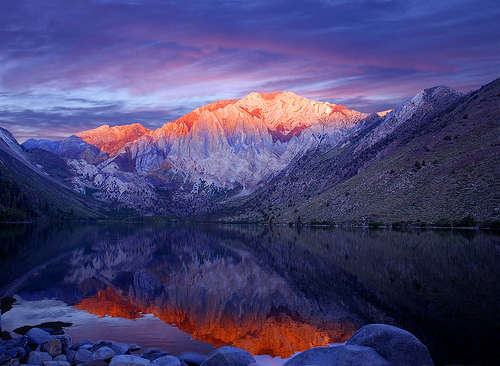Part two – be sure to read “The Future’s Bright! The Future’s Danish?” before you dive in. You’ll be glad you did.
America is a great and blessed nation, abundant in natural resources, purple-capped mountain majesties, swaying fields of wheat, and whatever other romanticized notions you want to paint your wagon with. What it also has are huge coastlines, rivers, vast plains, deserts, and wind. Perfect for large-scale renewable energy creation.
While Europe has partaken in the pleasures of the harbor, America in comparison is skirting around dark alleyways, airport toilets, oil-slicked parking lots at night, and indulging in funny handshakes in secret rooms.
America’s renewable energy generation has been slowly increasing, reaching 13 percent in early 2011. Considering that its previous peak was 11 percent in 1998, it has been a slow creep from 2001’s low of 7 percent. States like California, Iowa, and North Dakota get more than 10 percent of their power from wind, solar, and geothermal sources. A low 3 percent of the nation’s power comes from wind power alone. America is also home to the world’s biggest solar-thermal power plants in the Mojave desert, near Las Vegas. Recently opened Sheperds Flat Wind Farm in Oregon is the largest wind farm in the world, producing 845 MW. Google funded $100 million of the investment in the wind farm and have spent another $250 million in other renewable energy projects.
It’s oddly quixotic for America to view renewable energy in such a negative light given its history of projects like the Grand Coulee Dam in 1933, the Hoover Dam in 1936, or the Niagara Falls hydroelectric plant dating back to 1881. Projects like Solar One were developed in the 1970s under the Carter administration, which also installed solar panels on the roof of the White House. At the dedication ceremony in 1979, Jimmy Carter said:
In the year 2000 this solar water heater behind me, which is being dedicated today, will still be here supplying cheap, efficient energy … A generation from now, this solar heater can either be a curiosity, a museum piece, an example of a road not taken or it can be just a small part of one of the greatest and most exciting adventures ever undertaken by the American people.
So, what was the turning point for Europe and America? Why did one go forward and the other backwards?
In 1986, the Reagan administration removed the panels and gutted the R&D budget for the Department of Energy. The administration eliminated tax breaks for wind turbines and solar energy, and it doubled down on importing foreign oil. In an ongoing series of political negative doublespeak, “renewable energy” started to be called “alternative energy,” with all that is implied.
Europe has been gradually and more firmly moving away from nuclear power after the Chernobyl disaster when a huge radioactive cloud drifted over northern Europe, dumping fallout across the entirety of Northern Europe and killing 10,000 people. Over the last 15 to 20 years, the effects of global climate change (call it global warming if you want, and I’ll call you an ambulance) have been more pronounced throughout Europe with unprecedented floods, forest fires, shortened and missing summers, and exaggerated snowfalls in the winter.
The year 2003 alone saw a heatwave that killed 50,000 people across Europe, killing over 14,000 in Paris alone. At least 30 people died in America this summer. This year alone has seen snow fall on Central London in early December — something that has never happened in 40 years — and record cold weather earlier in 2012 saw hundreds of deaths in Eastern Europe as temperatures plummeted to -30 degrees. These haven’t been freak events, as one U.S, news pundit dubbed Hurricane Sandy, but a series of interconnected problems that have been gradually escalating within the space of one generation. And unlike America, the 24 hour news cycle hasn’t fully eroded people’s memories and attention spans in Europe, no matter how many British Royals get pregnant.
It has only been since around 2005 that solar power generation has been undertaken seriously in the United States, with numerous 500 MW generation plants being built. California is currently considering feed-in tariffs (that have been proven to be successful in Germany, Denmark, and the UK), to be followed by Hawaii and Michigan. Energy companies such as PG&E have voiced stiff opposition to such tariffs.
In recent years, political groups have created scandals out of thin air to discredit renewable energy. One such whipping boy used by various politicians has been Solyndra. A Californian company producing thin-film solar cells that received $535 million in government loans in 2008, based on applications made in 2005 under the Bush administration. However, early 2008 saw the price of polysilicon dropping sharply. North America had a large influx of natural gas reserves around the same time from shale gas. The Chinese government started to aggressively invest in the silicon open market, floating some $14 billion. Solyndra, and several other U.S.-based companies, found itself unable to compete. Coupled with ambitious over-expansion and spending, and poor management, the company fell into bankruptcy in 2011. The drop in the market also tore down several other companies, like Beacon Power and Konarka, placing them in the hands of private equity firms.




I’m definitely enjoying this series, Tim: hope to see more from you! And thanks for calling out why the US is lagging on renewable energy so concisely: I always have gotten lost in a maze of twisty factoids all alike when I’ve tried to figure it out.
Profits! Why should there be huge solar power plants in the desert SW when there should be solar panels on people’s houses instead?